A B2C Marketer’s Guide to Content-led Growth
Ever wonder how first-time consumers discover brands like Glassdoor, Airbnb, and Duolingo? These brands made the most of great content to reach their audience and help them solve specific problems. By creating content that is personalized and therefore, relatable, brands are able to move users along the funnel to eventually become paying customers for the brand.

Ever wonder how first-time consumers discover brands like Glassdoor, Airbnb, and Duolingo?
These brands made the most of great content to reach their audience and help them solve specific problems. By creating content that is personalized and, therefore, relatable, brands can move customers along the
funnel to become paying customers for the brand eventually.
There, we’ve just defined content-led growth for you!
Content-led growth refers to consistently creating and distributing valuable and relevant content to drive customers further along the purchase journey.
Content can be a great way to build a rapport with your target audience – it’s a neat way to tell them you know what the problem is and how you can help them resolve it with your product. This means positioning yourself as a trusted advisor. The purpose of content for B2C brands is clear:
- increase brand awareness
- engage with your audience
- build long-lasting relationships based on trust
Of course, driving sales is the ultimate purpose but not the first thing a brand should focus on when making content efforts. The idea is to connect with your target audience and position yourself as an expert in your industry.
A recent survey by Semrush revealed that 70% of B2C marketers use content marketing as part of their overall marketing strategy.
Moreover, the pandemic increased content usage by 207%. This should be all the more reason for B2C brands to leverage growth led by content.
Components of a Good B2C Content Marketing Strategy
In a recent survey, 78% respondents who achieved their content goals said they had a documented content marketing strategy.
So, before we get into the components of a good content strategy, let’s understand where it all begins.
Here’s a basic four-step process:
-
Plan your content:
Think about what you want to convey to your audience and why? More importantly, identify your target audience and segment them appropriately. Think about your expertise and create a unique point of view to grab attention.
It may help to ask yourself questions like “What is the problem my product is helping to solve?”
Of course, when you offer the solution, the customer will be the problem solver and your product, only the enabler or the sidekick.
Also, create a content calendar identifying the different types of content that you plan to create, be it videos, podcasts, blogs, listicles, and so on, and the release date for each content piece. Further, set up a distribution plan for these content pieces to promote them across platforms such as your website, social media platforms (LinkedIn, Twitter, YouTube, Facebook, etc).
-
Unlock your knowledge:
Convert your experiences, skills, and insights to valuable content.Here’s two handy tips to unlock your knowledge the right way:
- – Generating relevant topics – Topics that you choose should intersect between what the audience cares about and wants to know more about and what your expertise is . It may be wise to tune into social listening (identifying trends).
- – Offering insights – This could stem from a personal story or perspective, or simply be a detailed guide.
-
Produce content:
This is all about executing your content strategy. Create high-quality content in relevant formats (whether in-house or with the help of external partners) and distribute it across channels where you think your audience would be.
-
Observe:
This is the final step in the loop. Collecting audience feedback on your content is crucial to refine your strategy and find the sweet spot. Another tip is to get as much qualitative data as quantitative by, say, reading through comments on the brand’s social handles.
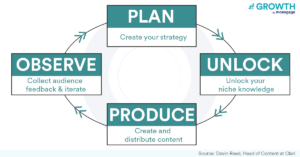
Now, to the key components that make a comprehensive content strategy.
The top three types of content being created by marketing teams in 2022 included videos, blogs, and images. However, a well-rounded B2C content strategy covers all ends.
Here’s how you can optimize some widely used formats:
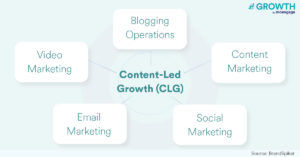
a. Email marketing
With a user base of 4.3 million in 2022, email retains the throne as the king of B2C marketing.
A definite advantage of email marketing is the ability of B2C brands to send lifecycle emails, that is, targeting emails based on the customer’s journey.
Here are 5 steps for crafting an effective email marketing campaign:
- Identify your goals – Decide what you want to achieve with the campaign.
- Build an email list – Build an email list of recipients before the campaign. You may capture leads for your email list via social media, blog, and web pages.
- Segment your list – For B2C brands, segmentation is important as your customers are at different stages at a given time. Segmentation can be based on age, gender, location, habits, preferences, and more.
- Draft and design an effective copy – It’s time to create email campaigns specific to each segment along with well-designed visuals. Remember, the email you draft will be different for each customer segment and customer lifecycle stage. So you will have to personlize it in terms of subject line, body copy, design, and call-to-action (CTA).
- Automate campaigns – If you want to save time and grow at scale, you would need to automate your email campaigns. There are numerous tools available to schedule emails, track and analyze responsiveness, and optimize your email marketing efforts accordingly.
Then, there are popular categories of emails depending on the purchase journey:
Welcome email – These are typically used for creating brand awareness when someone has just signed up. A warm welcome email serves as a great way to start a customer relationship.
Promotional email – These are used to announce a new product launch or any offers running at the moment.
In the example below, we see how Apple announces the launch of a new product in great style. Not only is the email copy crisp, but the email also scores full marks on the image quality.
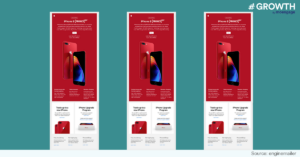
Abandoned cart email – These emails are particularly helpful for B2C E-commerce brands who struggle with drop-outs at the final stage of the buying journey. A little nudge to the customer via email may be appreciated if they didn’t have the time to complete the purchase.
Winback or re-engagement emails are also similar. The one below by Duolingo with a clear CTA aces email marketing on all counts.
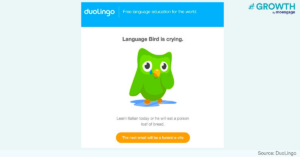
Newsletter or periodic updates – Such emails are a clever way to retain a connection with your prospects or customers. Brands may send updates or newsletters to position themselves as thought leaders in their domains.
Here’s an example of how Grammarly sends out a weekly writing update that is highly personalized.
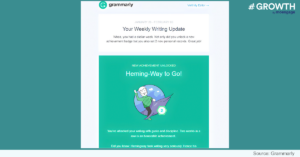
With email marketing, note that personalization, interactive design, and clear CTAs are key!
b. In-app push notifications
A Reckless’ study found that while email open rates were less than 2%, push notifications had an average open rate of a whopping 20%!
Push notification marketing allows sending marketing messages via “push” technology on both desktop and mobile devices.
Here’s what they look like –
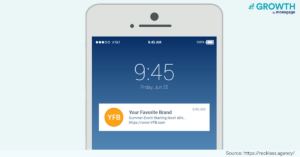
Clearly, B2C brands that are not using push marketing are missing out on big engagement opportunities, especially given that most of us are hooked on to our cellphones.
Push notification marketing is exceptionally useful in delivering powerful CTAs, especially when promoting a limited time sale, sending personalized recommendations, and announcing product launches.
An example of the effective use of push notifications is that of E-commerce brand “Boxed” which uses a rich notification to convey a limited-time offer for Cyber Monday.
The direct and urgency-driven message with a strong CTA is surely a compelling nudge for the recipient.
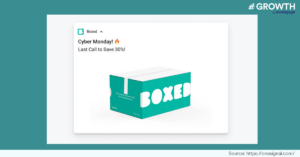
c. Blogging
Blogging remains an essential and powerful component of content marketing. A significant advantage of having a blog is the versatility it offers. Blogs have the potential to showcase your expertise via short form and long form content while embedding other formats like videos, images, and links. This makes it a highly sticky experience for visitors.
With a blog, you can promote other internal and external content via links, add social share buttons for greater engagement, and incorporate product information in a subtle manner.
While there is no single recipe for creating a successful blog, it does involve some key steps, the most important one being creating a buyer persona.
To do this, ask yourself these three questions:
- Which topics create awareness about your products and services?
- Which questions do buyers usually have when considering a product in your industry?
- What content helps buyers choose your solution over your competitors?
An example of a successful blog is Mashable.
Mashable started as a personal blog in 2005 and published news on social networks and technology.
What has worked in Mashable’s favour is its easy-to-digest content. Founder Pete Cashmore focused on stories being shared on blogs and social media and encouraged questions and feedback from the audience, making the readers an integral part of the storytelling process.
Mashable witnessed incredible reader growth and serves as a model blog for brands looking to start out.
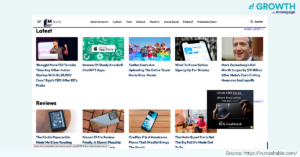
Some lessons from Mashable to follow for effective blogging:
- Post consistently.
- Generate content that your audience wants in the format they prefer.
- Encourage engagement and interaction.
- Focus on building a healthy community of followers.
- Enable sharing options across channels.
- Use a mix of appealing audio-visuals to make your blog less monotonous.
- Add internal and external links to relevant content.
d. Video marketing
In a world driven by the Internet, who can deny the dominance and power of video?
91% of businesses are using video as a marketing tool in 2023. Further, an overwhelming 96% of marketers continue to deem video as an “important component” of their marketing strategy.
Videos are versatile in that you can embed them on your social media platforms, landing pages, web pages, and even on the blog.
Here’s some important things to watch out for while making video content:
- Focus on stories & not sales.
- Use the first few seconds very wisely.
- Don’t forget to add appealing visuals.
- It may be wise to add subtitles where there’s a lot of talking.
- Target the right audience.
- Add a CTA either mid and post scroll for more engagement.
This video from Tech insider checks all the boxes.
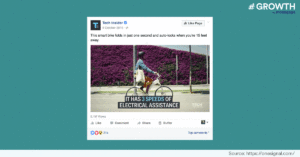
e. Social Media Marketing
There are more than 4.62 billion global social media users today! This is why so many B2C businesses are engaging in social media marketing. Platforms like Facebook, Instagram, Pinterest, LinkedIn, and Snapchat each have their own unique features that marketers can leverage to reach customers.
Here are 3 social media trends in 2023 for brands to follow.
Community building
Communities tend to promote active engagement and create a more welcoming environment for newcomers. Brands can focus on building and fostering such communities.
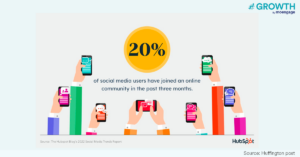
Social commerce
The global social-commerce market is poised to expand to more than $2 trillion by 2025. So what can brands do to leverage this growth? B2C brands can work with social and creator platforms while developing a more holistic influencer strategy. B2C brands also need to factor in formats like short videos or live shopping content to accommodate this new channel.
Micro influencers
It’s probably time for brands to transition to smaller influencers from mega celebrities to create a more credible connect with customers.
One exercise that cannot be emphasized enough is measuring results with social media analytics to fine-tune campaigns. There are abundant automation options for social media planning and listening. Using them can help brands stay ahead of competition.
f. WhatsApp marketing
WhatsApp has over 2 billion active users. At this scale, B2C brands cannot not leverage this platform!
WhatsApp allows marketers to seamlessly send broadcast messages. It is also a preferred platform for sending interactive messages with effective CTAs.
These work very well when retargeting customers as seen in the Duolingo screenshot below.
Personalized messaging is also possible with WhatsApp. Further, many B2C brands have taken to WhatsApp to automate instant customer support for better engagement, onboarding, and retention.
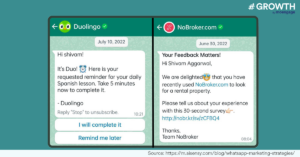
g. Podcasts
Over 60 million people listen to podcasts across Spotify and Apple Podcasts. As this number grows rapidly,odcasts opens many doors for B2C brands to build a connect with customers via informative episodes, interactive sessions, and expert interviews.
Mapping your B2C content strategy to the customer journey
Now that we’ve gone through the major components of a content strategy, it’s important to know that a good content strategy becomes even more effective when aligned appropriately with the purchase journey.
Here’s how you can map your strategy based on where your customer is along the funnel:
Awareness: At this stage, customers may have a need, but may not be aware that there is a solution. Formats like blogs, social media, web pages, and podcasts work well in this phase.
Research: Once a customer is aware there is a solution, they will carry on research to educate themselves about available options. For instance, a customer who wants to buy a car will try to find out the different types of cars and which one will suit their needs. This is where targeted email marketing, social media, and blogs may help customers know more about your offering.
Consideration: At this point, the customer starts comparing products from various brands to ensure they’re getting a high quality product at a fair price.
During this stage, demos may work well along with detailed videos of your product, reviews by influencers, blogs, promotional emails, and push notifications offering discounts.
Purchase: Finally, the customer has made up their mind and moves forward with the purchase. What works best here is email marketing and personalized WhatsApp messaging with clear CTAs to give them a little nudge and assist them through the transaction.
Airbnb: A Case Study in Content-led Growth
Airbnb started out as mattress-renting service started by founders Brian Chesky and Joe Gebbia who were struggling to make their monthly rent. Today, Airbnb has become an eponymous brand like Google and Uber for travellers across the globe. However, much of the hospitality industry’s initial success can be attributed to its clever content marketing strategy.
Taking an impressive approach to storytelling, Airbnb is perhaps the epitome of great user generated content, an exceptionally well-designed blog, alluring website, and a clear brand voice.
Airbnb makes the most of curated user experiences on its social media platforms, while the blog works as an informative space for travellers. Over the course, the company has experimented with content via magazines (Pineapple) and microsites (Stories) to weave a warm connect among hosts and travellers.
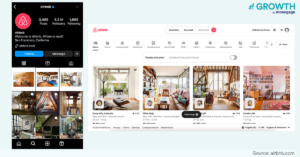
From rocky roads in 2009 to pulling off a successful IPO in 2020 (perhaps the worst year for the travel industry), Airbnb stands out as one of the top B2C content marketers.
TLDR? Here’s a quick summary:
- The purpose of B2C content is to create brand awareness and identity. Sales is the last priority.
- A well-planned content strategy includes diverse formats relevant to the brand. Among them are email, video, social media, push notifications, and blog.
- Brands can make the most of their content strategy by mapping it to the appropriate stage of the purchase journey.
- Ultimately, the goal of content in B2C marketing is to build trust at scale and engage with customers by creating high quality, highly relevant content.